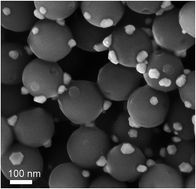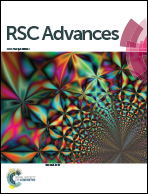Microbead silica decorated with polyhedral silver nanoparticles as a versatile component of sacrificial gel films for SERS applications†
Abstract
A new method of microbead silica preparation with superficially built-in 2–3 nm silver seeds is suggested by using a simple reaction of Stoeber SiO2 microspheres with hot aqueous solutions of diamminesilver(I) hydroxide without addition of reducing agents. The seeding beads initiate growth of polyhedral 20–50 nm silver nanoparticles encrusting silica surface after an instant heterogeneous contact with a mixture of silver nitrate and ascorbic acid solutions with concentrations of as low as 1 mM. The unique microstructure results in a pronounced, about 100 nm, red shift of the silver plasmonic band allowing fast and robust tuning of optical properties of the nanocomposites. Such microengineered building blocks are stored safely in a sacrificial biopolymer (ethylcellulose) film as its versatile component to be applied on demand in aqueous environment since polymer swelling absorbs water-soluble analytes and allows for the advanced SERS analysis.


 Please wait while we load your content...
Please wait while we load your content...